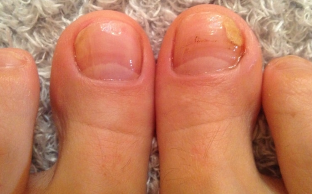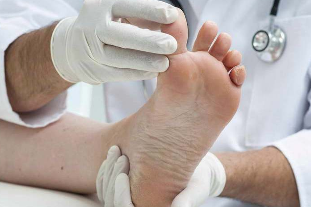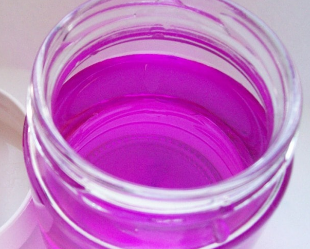The darkening of the surface of the nail, its thickening, splitting and warping – all of this can be a sign of development of nail fungus (onychomycosis). Many patients confuse the infection with bruises or psoriasis. To avoid the aggravation of the disease, it is necessary to know how to identify the fungus in the nails of the feet, its types and symptoms.
Types of nail fungus

Often the fungal infection does not just apply to the nail, but that affects approximately-Polish the area. Also suffers from the skin of the feet and interdigital folds such as the hands and the feet (athlete's foot). Among most commonly used agents are pathogens that cause negative changes we can highlight:
- yeast fungi – affect the nail of a finger, making it thinner, which leads to the categorization of the plate bed;
- exerts the action antifungal – penetrating in the horny layer, causing the appearance in her yellow stripes or blotches of white color, that with the time increase;
- rancid fungus – penetrates the upper layers of the plate and changes its colour to green, grey or black.
When the infection affects the nails, in the initial stages, will notice the first changes on the basis of which we can distinguish 3 main types of fungi.
- Onychomycosis distal. The defeat begins with the edge of the corneal layer and then the infection moves to the base of the plate. The nail becomes grayish tone, thickens or thins, the crumble of apple and with the time almost completely destroyed.
- The fungus. It extends from the center of the plate, causing the darkening and destruction.
- Superficial onychomycosis. It is accompanied by the appearance of white spots in the center of the nail or by their edges. In the beginning of the disease, the board does not have deformations, but to the touch it is notable for its movement, which with time leads to a change in the bed and the loss of the nail.
The first signs and symptoms of nail fungus
The development of the fungus does not pass hidden. Already a few days after exposure to the infection appear the first signs and symptoms, which with the time become more brilliant.
- The nail fades away, loses the brightness, the image changes to the plate, are yellow or white spots in the grooves of the band.
- Changes the shape of the nail, is deformation, which is accompanied, reinforced, or thinning of the horny layer. This condition leads to the delamination, the depletion of the plate, and thereafter, the bureau of the cylinder head.
- You experience sensations of pain when they are pressed. The corneal layer and nearby tissue is inflamed.
- The appearance of the diaper rash between the fingers and the unpleasant odor of the dead nail.

These symptoms and signs can help to identify a nail fungus in the early stages and distinguish it from other diseases (bruises, psoriasis, eczema, depriving).
The methods of diagnosis
The identification procedure of onychomycosis or mycosis generally passes through several stages, that include the specific methods of: clinical picture, microscopy.
Initially, the specialist draws the attention into the symptoms and patient's complaints, making the collection of clinical data. After the inspection nail plate and the skin around them medical pre-identifies the infection, without discussion of the disease (psoriasis, ringworm of red, the problems with the normal power of the nail).
For the accuracy of the confirmation of the disease, the specialist makes the extraction of material for the research microscpica. The affected area takes the scraping of the tissue is processed in the laboratory special of the substance.
Diagnose more accurately a type of fungus helps to the study of biological material. The analysis is carried out after the microscopy. It makes the planting of scraping. The sample of the affected tissue is placed in the nutrient for the fungus environment. After 3-5 days, you can get the results of the procedures. Type of fungus can be determined by the structure of the colony, of its peculiar growth, and of a light color.
Thanks to the diversity unmistakable of the research, defines the type of the virus and its sensitivity to certain antimicrobials. This allows not only to identify accurately the causal agent of the infection, but also to pick up an effective treatment.
How to determine the nail fungus at home?
The darkening of the surface of the nail, its movement and the exhaustion may not always be able to give testimony of onychomycosis. To find out if there is a fungal infection you can use the iodine and permanganate.
We determine the onychomycosis with permanganate
The procedure of identification of the fungi takes a little time and easy application. In a bowl with hot water you have to dilute a little bit of manganese, which has been weak in solution. Placing in the liquid of the hand or foot, wait for 5-10 minutes. During this time, healthy nails are turns in brown color, affected will remain intact.
The identification of fungi of the nails with the help of iodine
Unlike manganese, iodine may not indicate the presence of pathogens onychomycosis. The tool helps rule out other fungi, in particular, the pityriasis versicolor. If the skin around the nail appears peeling, redness, worth the areas to treat with iodine. Healthy skin is practically not darken under the alcohol solution, and, behold, a dead of depriving the place is saturated with dark color.
How to distinguish the mycoses of the nails of other diseases?
In the early stages of development of an infection can be confused with skin diseases (psoriasis, versicolor) or lesions of the nails. To not run negative reactions, it is important to know the main differences mycosis.

- The darkening of the surface of the nail, the appearance of yellow spots and longitudinal bands, which with time become more and penetrate more deeply into the nail.
- Soft to the development of the disease, with no exacerbations and calm, as is the case of psoriasis. The fungus gradually deforms the nail plate, to its detachment from the cylinder head.
- The appearance of bad smells and the painful sensations also offers a fungus of lesions or psoriatic defeat, eczema, depriving.
- The causes of the rise of the fungi you can visit public places (pool, sauna), the use of close footwear (micro injuries and wear and tear), the increased sweating of the feet, dermatitis of the diaper, as well as contact with an infected person.
- The fungus is originally in a toe, most often large, and then affects the rest of the phalanx and interdigital area.
Differences mentioned will help to identify the fungus in the early stages of its development. Important is to understand that self-diagnosis is not enough. For effective treatment is needed a specialist.
The athlete's foot – nasty and perverse of the disease, which is able to impersonate other pathologies (psoriasis, eczema). It is important to carefully monitor the nails of the feet, and when the suspicious symptoms in time to go to the doctor for a timely treatment.





























